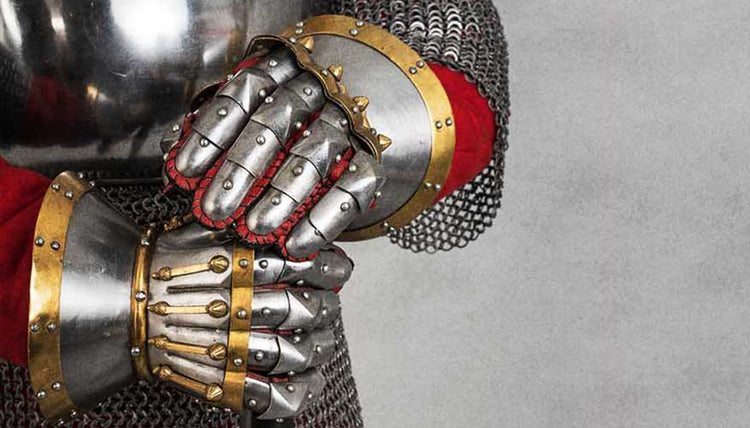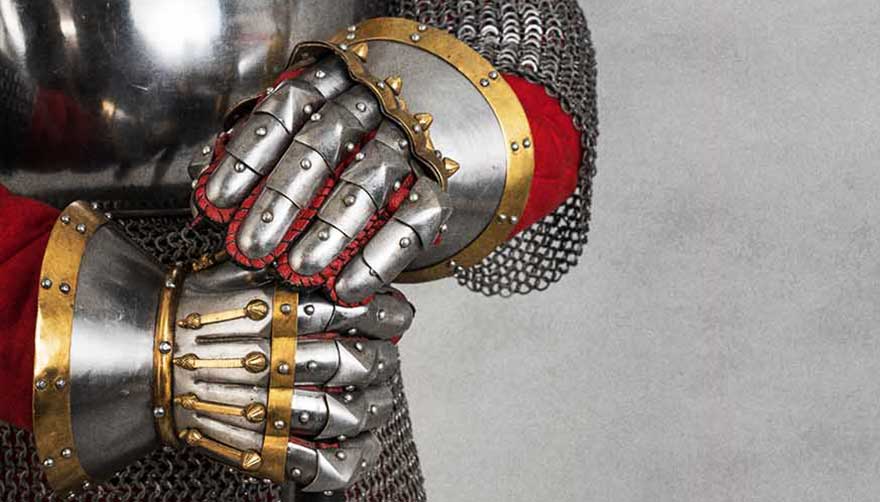Gloves
The hand of a knight is given the utmost importance in the Middle Ages. Idioms that we still use today as a matter of course originate from this time. That something has a "hand and a foot" follows from the statement that a knight was only capable of fighting if his foot held him in the stirrup of his steed and his hand could wield a sword.
Protecting one’s hands in battle, however, was an entirely practical, and not solely symbolic, task. An injured hand rendered a fighter incapable of fighting and largely defenseless in the moment. In the long run, the loss of the hand's ability to function marked the end for a knight or soldier.
The hand is a versatile and formidable tool, and at the same time, one of the most vulnerable parts of the body. A powerful blow could break bones and the cutting edges of various weapons could cause serious damage, which medieval medicine had not yet begun to cope with. Protection was consequently absolutely indispensable.
Gloves to ward against the cold have been around since early history. The first versions were anything but practical. Simple bag-like sleeves limited the functionality of the hands almost entirely. Only models with a separate thumb part, the first mittens, allowed the wearer to use their hand as a simple gripping tool. Already from ancient Egypt, however, the first finger gloves made of leather had been used.
Gloves gained early symbolic significance. They equally represent the power of the ruling classes as well as a part of ritual acts. Even today we recognize symbolic actions with gloves, which have been preserved in our linguistic usage. This includes the gauntlet as well as the disparaging gesture of smacking someone in the face with a glove to challenge them to a duel. Other gestures, such as throwing down gloves as a sign of opening a feud or picking them up as an accepting retort, have their origins in the age of chivalry.
Chivalry as Handwork
Until the High Middle Ages, knights wore gloves made of coarse leather with a wide cuff. From about the 13th century, the backs of the hands of leather mittens were studded with metal rings to give them more resistance.
Chain armour included chain mittens or even high-quality crafted finger gloves made of chain mesh.
The first armoured gauntlets used gloves made of deer and cowhide, on which metal plates were attached, which covered the back of the hand, the thumb, and sometimes individual fingers. To keep at least the thumb movable, the metal cover was hinged. The cover of the back of the hand, the so-called Hentze, ended in a cuff and protected the wrist. Together with bracers and plate shoulders, the gloves thus formed a unit that protected the entire arm.
The plate armour of the late Middle Ages was worn with elaborately crafted plate gloves. Elementary advances in metalworking allowed, in addition to very rough plate mittens, a comparatively precise elaboration of the individual fingers to the individual phalanges, which were movably connected and granted its wearer basic dexterity.
We Reach Out To You
Especially if your character in LARP or reenactment is of noble blood, it almost goes without saying that they will not take up arms without protecting their most valuable tools, their hands.
Our collection of plate gloves, plate mittens, and finger gloves, are an investment in your character's accouterments that may not be high on your priority list but are essential to completing your appearance.
The different models can be optimally combined with the matching plate arms and cover a wide range of common hand sizes with a one-size-fits-all fit.


















